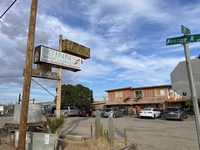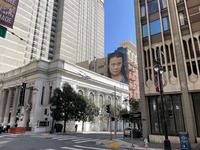 |
| Angelika/Mike Schilli |
|
|
|
Angelika Anyone who works at a school like I do enjoys the benefit of generously alotted vacation time, which is a real luxury in the USA. And now that Michael has recently become a freelance programmer and surfer, and is therefore very flexible with his time, we can use my vacations for traveling together.
Around Christmas, I had more than two weeks off, and we spent one of those weeks driving down to the Anza-Borrego Desert, which is located about 85 kilometers northeast of San Diego. We had been there many, many years ago, and had long intended to return. We packed our Honda Fit, affectionately called Brummi, and zoomed down south, making a stop in Santa Barbara, where we also hadn't been in ages.
Before we moved to the USA many years ago, I had a somewhat one-sided view of desert landscapes, thinking: It's hot, there's a lot of sand, it never rains, and hardly anything grows. Of course, that's not entirely true. The temperatures are indeed brutal, especially in the summer months, but the plant life is rich and very fascinating because it consists of particularly robust plants that withstand the dryness and weather conditions. The same is true for wildlife: In the Anza Borrego Desert, for example, there are lizards, mountain lions, coyotes, and bighorn sheep.
It's true that it rarely rains in the desert, but nonetheless, they do record precipitation during the winter months, about 6 inches, or approximately 150 millimeters, per year. For example, it was drizzling on the day we left. You can best imagine the Anza-Borrego Desert as a mountainous terrain with hidden canyons, but also magnificent expanses, a paradise for every hiker and nature lover. What always fascinates me the most in the desert is how quiet it is. A delight for city dwellers like us.
We rented a great Airbnb in the town of Borrego Springs. The cottage was not only superbly equipped but also extremely affordable by California standards, which made me initially think there must be a catch. But there wasn't. There was a horse living in a corral behind the house, but of course we weren't required to take care of the horse. However, Apache Tears, as the horse was named, always enjoyed some petting and attention, and contributed to our holiday idyll in the desert. The accommodation also had bicycles for free use. Since Michael couldn't go on long hikes every day due to his meniscus surgery, but cycling was no problem, we were pleased to have this mode of transportation.
Despite the many years since our last visit, the desert landscape had pleasingly not changed, and we were just as thrilled with the Anza Borrego Desert as the first time. Borrego Springs had improved its culinary offerings, though. However, what really caught our eye were the huge metal sculptures that stood out almost surreal against the blue sky throughout Borrego Springs. They hadn’t been there during our first visit. Rusty dinosaurs, eagles, horses, as well as prehistoric animals were now spread throughout the desert landscape. There are 130 of these sculptures! How did these end up in the desert? What’s the story behind them? An artist named Ricardo Breceda created these on behalf of Dennis Avery since 2008. Dennis Avery was an American philanthropist whose father had built the quite successful Avery company.
The brand 'Avery' is as well-known in the USA as 'UHU' is in Germany. Avery developed the first self-adhesive labels. The owner's son did not join the company himself, but as an heir, he had a substantial amount of money. Having lived in Borrego Springs with his own family for a long time and loving and wanting to protect the desert landscape, he acquired quite a bit of land there. He then met Ricardo Breceda and installed the idea of sculptures in the desert landscape, placing them on his private land, which is open to the public.
One can certainly debate the artistic value of these metal sculptures, but Borrego Springs has definitely gained a new tourist attraction. And if the area is kept free from being filled with houses because of it, I'm all for it. By the way, Dennis Avery passed away in 2012 at the age of 71, but the sculptures are now managed by a foundation. We toured the sculptures on our bicycles, as the area is quite expansive, and felt like we were on a movie set.
















